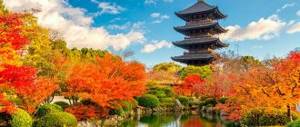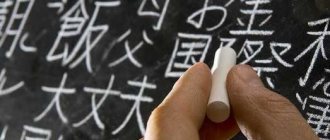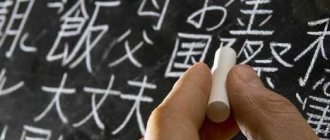OLD AND NEW NAMES OF JAPANESE MONTHS
Several times I heard either irony, or, conversely, some pleasure from the fact that the Japanese have such a simple system for designating months: the first month, the second month, and so on until the twelfth. And somehow, personally, the obvious thought did not occur to me that the names of some months in Russia (and, it turns out, in Europe) are also built according to the same system! And this discovery happened while looking at the next issue of my family’s favorite children’s and youth magazine “Koster”.
However, let’s read for ourselves:
It would seem, well, months like October and December clearly hint at eight and ten - how could you not notice?! This is obvious, but, apparently, the discrepancy between “okta” and “ten” and “deka” and “eleven” played a role.
So, as they say, there is no point in blaming the mirror, since... Well, then everyone already knows the continuation of the saying 
Dates
Writing dates is similar to using counting suffixes, one each for year, month and day.
- ~年【~ねん】 – year counter
- ~月 【~がつ】 - month counter
- ~日【~にち】 – day counter
The year counter is very simple as it has no variations in reading.
However, there are variations for months and a whole bunch of exceptions for days of the month. The two lists below list all the months in the year and the days in the month. Special readings or changes in reading are specifically highlighted. Months
| Month | Kanji | Reading |
| What month | 何月 | なん・がつ |
| January | 一月 | いち・がつ |
| February | 二月 | に・がつ |
| March | 三月 | さん・がつ |
| April | 四月 | し・がつ |
| May | 五月 | ご・がつ |
| June | 六月 | ろく・がつ |
| July | 七月 | しち・がつ |
| August | 八月 | はち・がつ |
| September | 九月 | く・がつ |
| October | 十月 | じゅう・がつ |
| November | 十一月 | じゅう・いち・がつ |
| December | 十二月 | じゅう・に・がつ |
Days of the month
| Day | Kanji | Reading |
| What a day | 何日 | なん・にち |
| 1 | 一日 | ついたち |
| 2 | 二日 | ふつ・か |
| 3 | 三日 | みっ・か |
| 4 | 四日 | よっ・か |
| 5 | 五日 | いつ・か |
| 6 | 六日 | むい・か |
| 7 | 七日 | なの・か |
| 8 | 八日 | よう・か |
| 9 | 九日 | ここの・か |
| 10 | 十日 | とお・か |
| 11 | 十一日 | じゅう・いち・にち |
| 12 | 十二日 | じゅう・に・にち |
| 13 | 十三日 | じゅう・さん・にち |
| 14 | 十四日 | じゅう・よっ・か |
| 15 | 十五日 | じゅう・ご・にち |
| 16 | 十六日 | じゅう・ろく・にち |
| 17 | 十七日 | じゅう・しち・にち |
| 18 | 十八日 | じゅう・はち・にち |
| 19 | 十九日 | じゅう・く・にち |
| 20 | 二十日 | はつ・か |
| 21 | 二十一日 | に・じゅう・いち・にち |
| 22 | 二十二日 | に・じゅう・に・にち |
| 23 | 二十三日 | に・じゅう・さん・にち |
| 24 | 二十四日 | に・じゅう・よっ・か |
| 25 | 二十五日 | に・じゅう・ご・にち |
| 26 | 二十六日 | に・じゅう・ろく・にち |
| 27 | 二十七日 | に・じゅう・しち・にち |
| 28 | 二十八日 | に・じゅう・はち・にち |
| 29 | 二十九日 | に・じゅう・く・にち |
| 30 | 三十日 | さん・じゅう・にち |
| 31 | 三十一日 | さん・じゅう・いち・にち |
For completeness, all days of the week are listed here.
- 何曜日 【なん・よう・び】 - what day of the week
- Monday
- Tuesday
- Wednesday
- Thursday
- Friday
- Saturday 【ど・よう・び】 – Saturday
- Sunday
OLD and ANCIENT NAMES OF JAPANESE MONTHS
But, since we are already talking about months, let’s turn the vector of the conversation towards the Japanese side.
If not everyone, then many know that in the past it was not so simple with the names of Japanese months. Let's look at the following table: Now
| Once upon a time | ||||
| January | 一月 | ichigatsu | 睦月 | mutsuki |
| February | 二月 | nigatsu | 如月 | kisagari |
| March | 三月 | sangatsu | 弥生 | yayoi |
| April | 四月 | shigatsu | 卯月 | Uzuki |
| May | 五月 | gogatsu | 皐月 | Satsuki |
| June | 六月 | rokugatsu | 水無月 | minazuki |
| July | 七月 | shitigatsu | 文月 | fumizuki |
| August | 八月 | hachigatsu | 葉月 | hazuki |
| September | 九月 | kugatsu | 長月 | nagatsuki |
| October | 十月 | ju:gatsu | 神無月 | kannaztsuki |
| November | 十一月 | ju:ichigatsu | 霜月 | Shimotsuki |
| December | 十二月 | ju:nigatsu | 師走 | Sivasu |
| 睦月 | mutsuki | 睦 BOKU mutsumaji - friendly, harmonious | "Month of Harmony" |
| 如月 | kisagari | 如 JO, NIO siku - to be similar, equal | "The month when they wear a lot of clothes" |
| 弥生 | yayoi | 弥 MI BI - even more 生 SEY ikiru - to be alive, haeru - to grow | "Month of Growing" |
| 卯月 | Uzuki | 卯 BO: Hare (horoscope), direction east | “Month of Deutia” Deutia (a shrubby plant that blooms profusely in late spring - early summer) |
| 皐月 | Satsuki | 皐 KO: | "Month of Rice Planting" |
| 水無月 | minazuki | 水 SUY mizu - water, 無 MU, BU nai - not | “A month without rain” The old Japanese calendar was based on the Chinese calendar, so there was a difference from three weeks to a month and a half with the European calendar, which is why today the “month without rain” falls precisely during the summer rainy season  |
| 文月 | fumizuki | 文 BUN MON writing, literature | "Poetry Writing Month" |
| 葉月 | hazuki | 葉 Yo: ha - leaf | "The Month of Falling Leaves" |
| 長月 | nagatsuki | 長 TO: nagai - long | "A Month of Long Nights" |
| 神無月 | kannaztsuki | 神 SIN kami - god, 無 MU, BU nai - not | “A month without gods” This month the gods held either a coven, or a rally, or a symposium at the Izumo Shrine - they dropped everything and gathered for this meeting |
| 霜月 | Shimotsuki | 霜 SO: simo - hoarfrost, hoarfrost, frost | "Month of Frost" |
| 師走 | Sivasu | 師 SI - Teacher, spiritual father 走 SO: hashiru - run | “The Month of Finishing Things” (Month of Running Monks) The end of the year - so many things to do, so many things to do!!!  |
26.04.2016
Other opuses
Date formats
The date format used in Japan is similar to the international format used in many other countries around the world: year, month, day, in that order. Again, using numbers to make reading easier is quite common.
In addition, when filling out official documents, you may come across a different calendar, traditional in Japan, based on the reign of each emperor. The chronology in such a calendar begins anew from year 1 (called 元年【がん・ねん】) at the beginning of the reign of each new emperor, along with the name of the era. For example, the era of 「平成」 began in 1989, therefore 2009 would be 平成21年. If you live in Japan, you may find it helpful to remember the current year and your date of birth according to the Japanese calendar. The eras for approximately 100 previous years are listed below. You can also search the Internet for convenient converters or tables with all the years.
- 平成【へい・せい】 - Heisei era (1989/1/8 –)
- 昭和 【しょう・わ】 - Showa era (1926/12/25 – 1989/1/7)
- 大正 【たい・しょう】 - Taisho era (1912/7/30 – 1926/12/25)
- 元年 【がん・ねん】 - the first year of an era, lasts until the end of that year (December 31)
Examples
- 2?・か】2009/12/24
- 2010年4月1日(木曜日)よう・び)】April 1, 2010, Thursday
- The・じゅう・にち】1981/11/30
- 1989/9/9
HIEROGLYPH "SUMMER" (NATSU) and "WINTER" (FUYU)
The character 夏 (summer) is mysterious. It is quite difficult to find any sensible explanations for its graphics that would lead to an understanding of the connection with the summer season. And if you consider that this hieroglyph four thousand years ago in China designated one of the dynasties, then the question generally arises of what it would mean and where it came from.
And yet, our task is to try to at least somehow link it with our experience, and in any way - just to be able to reproduce this sign easily and freely on occasion. So, let's take a closer look.
First of all, one element is striking, which is also present in the character 冬 (winter). To the author of these words, in the case of Winter, the element 夂 (in the “world” key 34) resembles a roof from which an icicle hangs.
Why an icicle? Yes, because those two dots at the bottom of the character 冬 (winter) definitely hint at ice: 氷 (HYO: koori) - ice. The connection of the “dots” with ice is even better visible if you look at the more ancient sign “Ice”: 冰 - it is clearly visible that these are crystals (two dots on the left) of water 水 (SUI mizu).
So it turns out that with the arrival of winter the roof freezes. But if this is, say, a roof (here, of course, the guardians of the purity of hieroglyphic truths will throw snowballs and stones at us), then in the summer it is clearly the same roof, but only on which a bird sits and turns its head. Why with the head and not the tail? Yes, because the top element clearly comes from the hieroglyph 首 (SY kubi neck, head).
Yes, I always saw these two hieroglyphs and shared this vision. But in reality, everything is much more complicated, and for those who want more historical truth (although where is this truth when it comes to hieroglyphs?), let us remind you that the 34th key is often interpreted as moving forward, walking, and therefore , the element 夂 clearly comes from the image of legs.
And why not, because here’s what happens: 冬 (winter) are the legs of 夂 walking on the ice of 冰. And summer, just between us, is the time when a bad head gives no rest to the legs and crowds of those who want and suffer for summer adventures move towards the south, seas, forests - and anywhere, just to go, relax, see the world. It's summer!
So is this all real or not - does this “touch” anyone? The main thing is that we not only remembered the hieroglyphs 夏 (summer) and 冬 (winter), but also remembered what “ice” looks like 氷 or 冰, and the hieroglyph “neck” 首 
01.06.2016
Other opuses
Numbers of the month and dates in Japanese
Today we will learn how to name the numbers of the month and dates in Japanese.
European chronology in Japan
Currently, chronology in Japan has two types: European and Japanese. The first thing to remember when writing a date in Japanese, but according to the European chronology, is that it is written in reverse order, that is, first the year, then the month and finally the day. You can also add the day of the week at the end.
As an example, let’s take the date (by the way, the word “date” itself will sound like hidzuke – 日付) December 20, 2015 . In Japanese, “year” is nen 年, “month” is gatsu/getsu 月, and “day” is hi 日. So, taking into account the peculiarity of writing the order of numbers in a date, December 20, 2015 will be written as 2015年12月20日. And if you add the day of the week (in this case, this is Sunday - nichiyobi日曜日), you get 2015年12月20日日曜日(nisen jūgo nen jūnigatsu hatsuka nichiyōbi). Despite the fact that Arabic numerals are actively used in Japan, you can just as easily find hieroglyphs denoting numbers. If we replace the Arabic numerals indicating the month and day in our date with Japanese kanji, it will turn into 2015年十二月二十日日曜日. The year is very rarely written using hieroglyphs.
Names of months and numbers in Japanese
Remembering the names of the months in Japanese is quite simple: just know the numerals from 1 to 12 and add the hieroglyph 月 gatsu (month) to them:
January -一月-1月- ichi-gatsu February -二月- 2月- ni-gatsu March - 三月 - 3月 - san-gatsu April - 四月 - 4月 - shi-gatsu May - 五月 - 5月 - go-gatsu June - 六月 - 6月 - roku-gatsu July - 七月 - 7月 - shichi-gatsu August - 八月 - 8月 - hachi-gatsu September - 九月 - 9月 - ku-gatsu October — 十月 — 10月 — juu-gatsu November — 十一月 — 11月 — juu-ichi-gatsu December — 十二月 — 12月 — juu-ni-gatsu
The most difficult part is to learn the atypical Japanese readings of numbers from 1 to 10, and then simply add the word nichi (日) to the numeral. But even here we need to pay attention to three exceptions, which include the 14th, 20th and 24th:
1日 — 一日 — tsuitachi — first (1st) 2日 — 二日 — fust(u)ka — second (2nd) 3日 — 三日 — mikka — third (3rd) 4日 — 四日 - yokka - fourth (4th) 5日 - 五日 - its(u)ka - fifth (5th) 6日 - 六日 - muika - sixth (6th) 7日 - 七日 - nanoka - seventh (7th) 8日 - 八日 - youka (yooka) - eighth (8th) 9日 -九日 - kokonoka - ninth (9th) 10日 - 十日 - tooka - tenth (10th ) 11日 — 十一日 — jyuu ichi nichi — eleventh (11th) 12日 — 十二日 — jyuu ni nichi — twelfth (12th) 13日 — 十三日 — jyuu san nichi — thirteenth (14th) oe) 14日 -十四日 - jyuu yokka - fourteenth (14th) 15日 - 十五日 - jyuu go nichi - fifteenth (15th) 16日 十六日 - jyuu roku nichi - sixteenth (16th) ) 17日 — 十七日 — jyuu sh(i)chi nichi \ jyuu nana nichi — seventeenth (17th) 18日 — 十八日 — jyuu hachi nichi — eighteenth (18th) 19日 十九日 — jyuu ku nichi - nineteenth (19th) 20日 - 二十日 - hats(u)ka - twentieth (20th) 21日 - 二十一日 - ni jyuu ichi nichi - twenty-first (21st) 22日— 二十二日 — ni jyuu ni nichi — twenty-second (22nd) 23日 — 二十三日 — ni jyuu san nichi — twenty-third (23rd) 24日- 二十四日 — ni jyuu yokka — twenty-fourth = 24th 25日 — 二十五日 — ni jyuu go nichi — twenty-fifth (25th) 26日 — 二十六日 — ni jyuu roku nichi — twenty-sixth (26th) 27日 — 二十七日 - ni jyuu shichi nichi \ni jyuu nana nichi - twenty-seventh (27th) 28日 - 二十八日 - ni jyuu hachi nichi - ttwenty-eighth (28th) 29日 - 二十九日 - ni jyuu ku nichi - twenty-ninth (29th) 30日 - 三十日 - san jyuu nichi - thirty-first (30th) 31日 - 三十一日 - san jyuu ichi nichi - thirty-first (31st)
Also, the last day of the month can be called 晦日misoka (lit. “day of the end”), and December 31st 大晦日 ōmisoka (“day of the great end”).
If you do not yet know how to read Japanese, but would like to learn, then we advise you to master the Japanese alphabet - hiragana and katakana. It is, of course, better to start with hiragana. Take advantage of our free lessons to learn hiragana more effectively.
Japanese chronology
The Japanese chronology is a little more complicated than the European one. The fact is that the Japanese each time begin a new countdown from the accession of a new emperor to the throne. The current Emperor Akihito began his reign in 1989, that is, the current era, which is called Heisei, began in this year, and the first year of the reign is called 元年 - gan nen (the name of the first year of each era), and 1989 is called 平成元年- heisei gannen.
The current year 2015 is the 27th according to Japanese chronology, so December 20, 2015, which was taken as an example above, will be written as follows: 平成27年12月20日(Heisei nijūnana nen jūnigatsu hatsuka) or 平成27年十二月二十日 Below are the eras that belong to the 20th century:
明治時代 Meiji jidai - the reign of Emperor Meiji (1868-1912)大正時代 Taishō jidai - the reign of Emperor Taishō (1912-1926)昭和時代 Shōwa jidai - the reign of Emperor Showa (1926-1989)平成 Heisei - the reign of Emperor Akihito ( 1989-present)
If you take a Japanese coin in your hand, you will see that the issue date on it is written using the Japanese chronology. It is also often found in Japanese newspapers and official documents.
Try to learn a short dialogue related to dates (you can choose any date):
A:きょうは何月何日ですか。What is the date today? Kyō wa nani tsuki nan nichi desu ka B:5月21日です。Today is May 21st. Go-gatsu ni jyuu ichi nichi desu
Finally, do a short activity on writing dates.
In the comments, write the dates listed below and your birthday (or any other date important to you) in two ways, using the European and Japanese chronology:
February 25, 5 of the Showa era July 5, 1 of the Taisho era April 8, 22 of the Meiji era September 30, 8 of the Heisei era
Do you want to quickly learn how to read Japanese alphabet? We have a mini-course for you on learning hiragana in 5 lessons!










